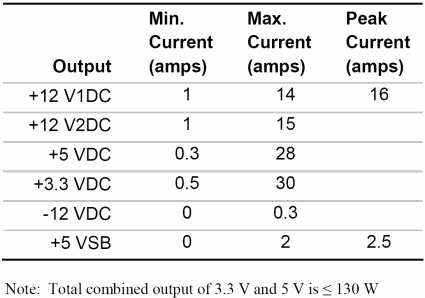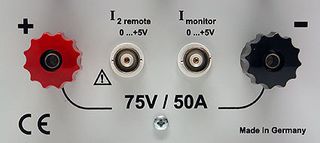More Performance: The New Power Supply Standard, ATX12V 2.0
Performance Specifications
One huge problem with power supplies are deviations in the specifications. A power supply cannot always be loaded to full capacity under all types of conditions. While the ATX Power Supply Design Guide contains typical configurations for output classes of 250 to 400 W, these are not binding. Each manufacturer can set its own output power data.
Tables show how much current can be distributed on each path. A sticker with this information is often attached to the power unit. The Power Supply Design Guide contains such tables for typical configurations; below is an example for 400 W:

Typical power distribution for a 400 W configuration
Great care is called for when interpreting the table. If you simply add up all the outputs in the table, you end up with 600 W! The key issue to pay attention to is which outputs can be used in which combinations. The "Cross Loading Graph" clues you in; it lets you see the maximum combined output for every conceivable operating point of the power supply, and thus calculate the electricity ratings.

Cross loading graph for 400 Watt configuration
The X-axis shows the 12V power values (combined) and the Y-axis shows the combined power of the 3.3V and 5V DC output voltages. For example, with an output of around 345 W on 12V, a total combined output of 50 watts is possible with 3.3V and 5V. On the other hand, if 130 watts is needed at 3.3V and 5V combined, this yields only about 170 W available on the 12V path. In this latter case, only 300 W combined output is possible. What this means is that there's a trade-off, and the maximum current for each rail can only be achieved at the correct operating point of the power supply in each case. Unfortunately, this diagram is generally missing from PSU documentation, so users are hard-pressed to figure out how the power supply is configured. The diagrams in the Power Supply Design Guide at least provide some general guideline values.
The THG Power Supply Test Platform
Our old test rig could no longer keep up with the ever increasing outputs of newer power supplies, so we developed a new one that we'd like to introduce to you.
Stay on the Cutting Edge
Join the experts who read Tom's Hardware for the inside track on enthusiast PC tech news — and have for over 25 years. We'll send breaking news and in-depth reviews of CPUs, GPUs, AI, maker hardware and more straight to your inbox.
We went with the PC-NT-TB2 power supply test bay from Willer Engineering, which is adjusted for testing ATX 2.01 power supplies.
Output Voltage
The four main voltage channels are loaded with 2x +12V, +5V and +3.3V using electronic loads. Each of these loads can handle a maximum current of 50 amperes, which yields maximum output values of 600 watts per 12V path, 250 watts at 5V and 165 watts at 3.3V. That means that it is possible to record measurements for power supplies with up to 1.6 kW of output. Continuous power, however, is a "mere" 400 watts per machine, which would theoretically mean that it could power PSUs up to 1.2 kW.

Power supply test rig in action

Electronic high performance load from Statron

Maximum current 50A! At 12V that produces 600 watts of power just at that one voltage
The DC loads' finely adjustable settings can measure load capacity and voltage stability at nearly every operating point of the power supply. Two different load strengths can be preset, and you can switch back and forth between them. This allows you to simulate a load that changes, such as occurs in a PC when there is a sudden peak in the CPU load.
Most Popular

